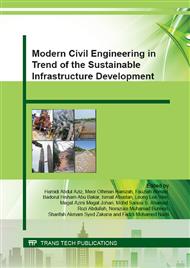p.303
p.309
p.315
p.321
p.327
p.333
p.339
p.345
p.351
Effects of Wax Additive on the Rheological Properties of Asphalt Binder
Abstract:
Environmental problems caused by high temperature during the production of asphalt and road paving prompted research on alternative material that is more environmental friendly. Recent advances in asphalt technology have allowed the reduction of construction temperature using the warm mix asphalt additives. This paper presents the laboratory results on the effects of a wax warm mix additive on the asphalt binder rheological properties. The additive were blended with conventional binder using laboratory mechanical mixer at 0, 1, 2, 3, 4 and 5% by the mass of binder. Then, the binders were tested for flow properties, stiffness and its resistance to rutting and fatigue. Tests were performed using rotational viscometer and dynamic shear rheometer on unaged and aged samples. The results show that the addition of wax warm mix additive improves the flow properties by reducing the viscosity and leads to lower construction temperature. Characterization of modified binders’ rheological properties at intermediate and high temperature indicates that the amount of wax warm mix additive addition slightly affects the binder stiffness and its resistance to rutting and fatigue. Based on the rheological test results, the 3% wax warm mix additive produce comparable rheological properties with the conventional binder. Therefore 3% wax warm mix additive is suggested to be the optimum amount for the road construction application.
Info:
Periodical:
Pages:
327-332
Citation:
Online since:
October 2015
Authors:
Keywords:
Price:
Сopyright:
© 2015 Trans Tech Publications Ltd. All Rights Reserved
Share:
Citation:


